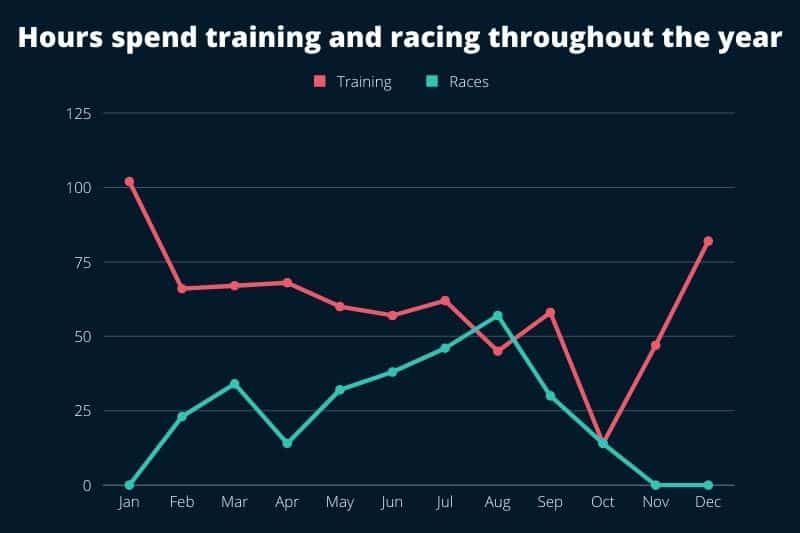While watching Tour de France, did you ever wonder how much the pros train? I know I have. Three weeks of racing at the highest level require extreme physical fitness. So how much training is actually needed beforehand?
On average, professional cyclists spend 738 hours a year training. In that time, they cover 13,736 miles (22,106 km), which is equivalent to about six and a half Tour de France lengths.
The amount of training and its distribution over the year varies from rider to rider. I will explain exactly how in the rest of this article.
How many miles per year do pro cyclists ride in training?
Before a cyclist can even dream about winning some races, he must put a lot of effort into training. He has to ride for miles and miles before he’s ready to suffer on a race.
I collected training data from 35 professional cyclists who were part of World Tour teams in the 2021 season. I analyzed their training mileage and got some exciting results.
On average, pro cyclists cover 13,736 miles (22,106 km) during training per year. However, the number varies heavily between individuals. The cyclist with the longest distance covered 18,093 miles (29,112 km), and the cyclist with the shortest distance covered 11,711 miles (18,843 km).
The difference between the cyclists with the highest and the lowest mileage is significant. To put it in cycling perspective, the difference is three Tour de France lengths.
I also analyzed the overall annual mileage of professional cyclists, both men and women. You can find the article here.

How many hours per year do pro cyclists spend training?
More often than not, professional cyclists measure their training in hours rather than in miles.
For example, they need to do ten 4-minute intervals at a certain power. They don’t care how many miles they cover during that time, as long as the interval is indeed four minutes long.
Miles don’t matter, it’s the training hours that count.
If professional cyclists care about training hours, so are we. So let’s look at the numbers.
On average, professional cyclists spend 738 hours a year training. That is about 14 hours per week or 2 hours per day. The most training hours in 2021 recorded is 996, while the lowest number is 530.
Once again, the difference is a few lengths of Tour de France – 5.6 to be precise.
Training is not distributed equally throughout the season. At the beginning of the season, cyclists spend more than two hours a day training, and in the off-season, they spend less. But more on that later on.
Distribution of pro cyclists’ training throughout the year
The cycling season comprises several different periods, each with its own requirements and characteristics.
Pre-season is different from the main season, and the main season is different from the off-season. Even the main season itself has different periods during which training differs.

As you can see on the graph above, the most extensive training period is pre-season, when cyclists start to get back in shape. December and January are when teams organize training camps. Therefore, a lot of training is done.
In February, the first races occur, and almost every cyclist competes at at least one. Traning volume drops significantly and stays at that level over most of the season.
The closer we are to the major races – Tour de France, etc. – the more racing hours replace training hours.
August is the only month where racing volume is higher than training volume. There are two reasons for this:
- La Vuelta a España is taking place
- Cyclists that were riding on Tour de France in July are taking a break
A combination of both is why we see more racing hours than training hours. 184 riders who competed at Tour de France take at least two weeks off, while 184 riders are putting in hours at La Vuelta a España.
Many riders finish their season in September already, while others compete on the last races of the season in October. Either way, not much racing or training is done in October, as this is pretty much the only month that riders can have time off.
In November, preparations for the new season start, and the amount of training starts to pick up again.
How do injuries impact the amount of training?
I need to mention one crucial factor that influences the stats above. All of the cyclists included in my analysis avoided any major setbacks during the season. No one was injured or sick for an extended period, so they could train as much as possible.
Injuries obviously impact cyclists’ season. At first, training is not possible, then they are slowly returning on a bike, and when they’re fully fit, the shape they’re in is not great at all. So instead of racing, more training is required.
Injuries are a cyclist’s worst enemy.
The training to race ratio is therefore much different than it would be without the injury. But not only that, the overall number of miles ridden is significantly lower due to enforced rest.
Robert Gesink and Cyril Lemoine both crash out of Tour de France in 2021. Both were out of action for six weeks, which was reflected in their training numbers. Gesink covered 33% fewer miles in the month after the crash, while Lemoine mileage dropped almost 75%.
Does the amount of training depend on age?
Age is an important factor in sports, and cycling is no different.
More and more young riders are coming through the ranks to the elite level, where they manage to be competitive despite their young age.
The average age of Grand Tour winners over the last three seasons is 25.5 years.
The big question is, are they more used to putting in extra effort than the older guys, or are they just more talented?
There is no significant correlation between the age of the cyclist and the amount of training. There is a difference in the amount of training between age categories (juniors, under-23, etc.), but once a rider moves to the elite level, the amount of training is similar, regardless of their age.
Out of 35 riders whose training stats I analyzed, the second-oldest cyclist covered the most miles. You might think this means that older cyclists train more, but the cyclist with the second-highest mileage is only 24 years old, while the third-ranked cyclist is 23 years old.
At the other end of the scale, the story is similar. The 28-year-old has covered the fewest miles, while the 34-year-old is second to last. The top five with the lowest mileage also include a 23-year-old.
So it’s safe to say that age does not affect the amount of training!

